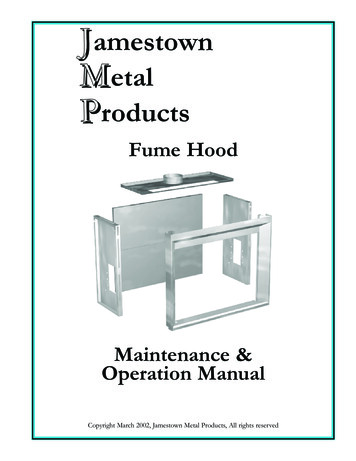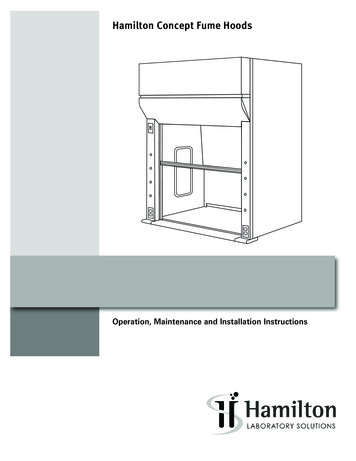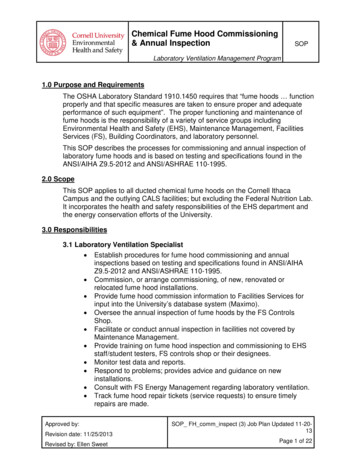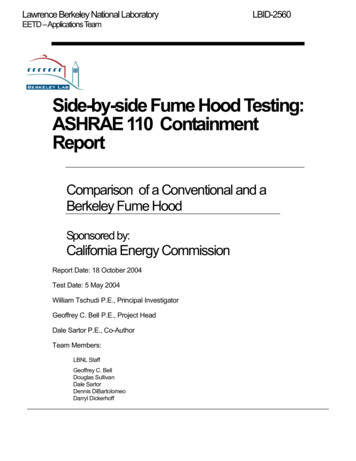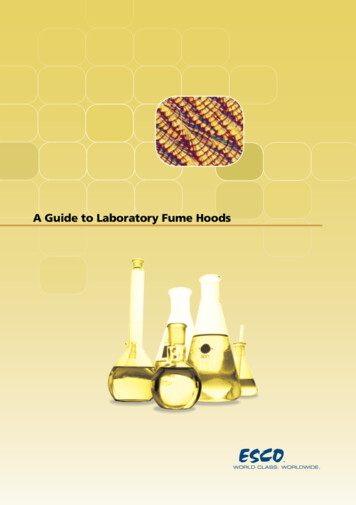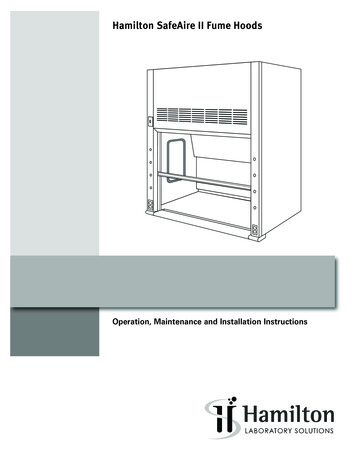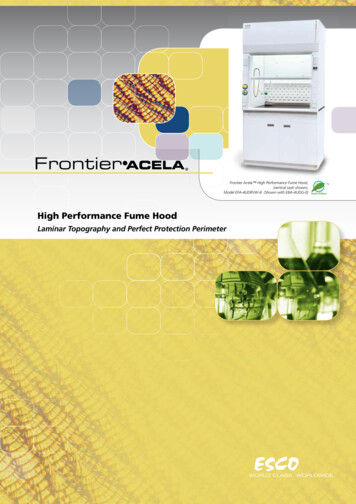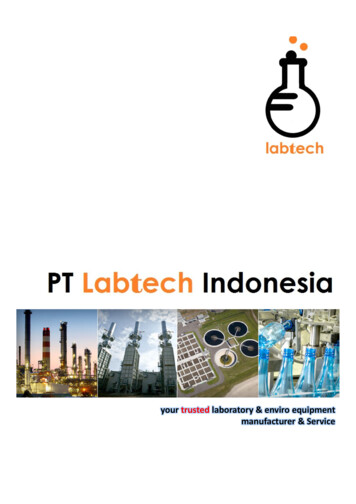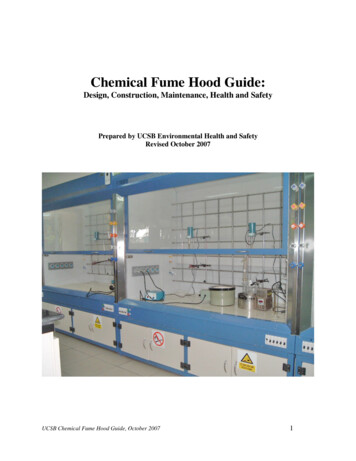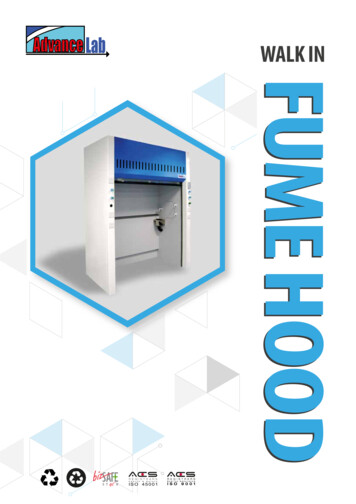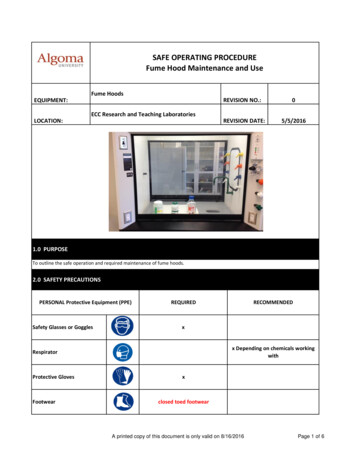
Transcription
SAFE OPERATING PROCEDUREFume Hood Maintenance and UseFume HoodsREVISION NO.:EQUIPMENT:0ECC Research and Teaching LaboratoriesREVISION DATE:LOCATION:5/5/20161.0 PURPOSETo outline the safe operation and required maintenance of fume hoods.2.0 SAFETY PRECAUTIONSPERSONAL Protective Equipment (PPE)Safety Glasses or GogglesREQUIREDxx Depending on chemicals workingwithRespiratorProtective GlovesFootwearRECOMMENDEDxclosed toed footwearA printed copy of this document is only valid on 8/16/2016Page 1 of 6
SAFE OPERATING PROCEDUREFume Hood Maintenance and UseFume HoodsREVISION NO.:EQUIPMENT:0ECC Research and Teaching LaboratoriesREVISION DATE:LOCATION:5/5/2016Principal hazards include:A chemical fume hood consists of an enclosed working chamber with an exhaust ventilation system attached. Theworkspace of the fume hood is ventilated by an induced flow of air through the face opening. The air flow is intended tocapture and contain gases, vapours or aerosols generated within the enclosure. These airborne contaminants are thenexhausted from the cabinet. Laboratory fume hoods are used as a primary means of protection to the employee/studentfrom inhalation of and exposure to odorous and/or hazardous chemicals3.0 TOOLS, EQUIPMENT & MATERIALSAs required for maintenance/repair4.0 TRAINING & CERTIFICATIONAll users must review this SOP, have had WHMIS training, and have completed all required inspections prior to starting.All work in fume hood must be done in accordance with safe practices for each technique5.0 OPERATING PROCEDURESA printed copy of this document is only valid on 8/16/2016Page 2 of 6
SAFE OPERATING PROCEDUREFume Hood Maintenance and UseFume HoodsREVISION NO.:EQUIPMENT:0ECC Research and Teaching LaboratoriesREVISION DATE:LOCATION:5.15.25/5/2016General Use Chemical Fume HoodsIt is highly recommended that all operations that involve the following WHMIS hazard classes be performed in afunctioning fume hood. Class B; Flammable and Combustible Materials Class C; Oxidizing Materials Class D1 (a & b); Materials with Immediate and Serious Toxic Effects D2 (a); MaterialsOther Toxic fumeEffectshood. Ensure that the fume hood is on before commencing anyDoClassnot conductwork in awithmalfunctioningwork. (Note – Fume hoods should be kept running at all times).A printed copy of this document is only valid on 8/16/2016Page 3 of 6
SAFE OPERATING PROCEDUREFume Hood Maintenance and UseFume HoodsREVISION NO.:EQUIPMENT:0ECC Research and Teaching LaboratoriesLOCATION:5.3REVISION DATE:5/5/20161. Substitute toxic chemicals with less hazardous materials whenever possible.2. No adjustments to the interior of the fume hood, (i.e. baffles) or to mechanical sash stops should be made.3. The sash of the fume hood should be kept closed except when making adjustments to equipment or actuallycarrying out manipulations in the fume hood. At those times the sash should be raised to it’s certified heightbased on face velocity testing.4. All equipment and materials should be placed at a minimum of six inches back from the face of the hood inorder that these items not obstruct the movement of air into the hood.5. It is recommended that blocks or racks be used to elevate equipment one or two inches off the hood decksurface in order that air flow easily around all apparatus.6. Never put your head inside a hood while operations are in progress and potential contaminants are beinggenerated.7. Use extreme caution with ignition sources inside a fume hood. Electrical receptacles or other spark sourcesshall not be placed inside the hood when flammable liquids or gases are present.8. Keep the interior of the fume hood clean and tidy. Clean up any spills immediately.9. Keep storage in the fume hood to a minimum. The hood should not be used as a storage area for chemicalsnor should it be overloaded with unnecessary equipment and materials. The presence of these materials canseriously affect the airflow in the fume hood.10. Do not use the fume hood as a waste disposal mechanism (e.g., for evaporation of chemicals). Refer to theHazardous Wastes Procedures for instructions on waste disposal.11. Foot traffic past the face of the fume hood should be kept to an absolute minimum while it is being used. Airflow caused by such traffic can seriously impede the operation of the hood and cause gases and vapors to bedrawn out of the hood and into the laboratory.12. It is recommended that chemicals and amounts used should be recorded in a log book, dedicated to one fumehood, in order that appropriate monitoring protocols may be used.A printed copy of this document is only valid on 8/16/2016Page 4 of 6
SAFE OPERATING PROCEDUREFume Hood Maintenance and UseFume HoodsREVISION NO.:EQUIPMENT:0ECC Research and Teaching LaboratoriesREVISION DATE:LOCATION:5/5/20166.0 INSPECTION REQUIREMENTSEmergency and Scheduled Maintenance of Fume Hoods is the responsibility of Physical Plant and all other6.1 inquiries regarding these matters should be directed to that departmentIn accordance with CSA Standard Z316.5-94, every six months the baffle(s), sash and interior surfaces of fume6.2 hoods shall be cleaned as applicable by the user.Every twelve months, the maintenance schedule shall include the following (as applicable): Inspect the sash mechanism for corrosion and damage; Inspect the fans, motors, drives, and bearings for correct operation and wear; Operate the wash down system and observe the performance to ensure thorough washing; Test the controls of the services to the fume hood for proper operation;6.3 Check the stability and condition of the discharge stack; Check the laboratory make-up air balance and temperature and adjust as necessary; Check the operation of any balancing damper; Repair defects and lubricate as necessary;A printed copy of this document is only valid on 8/16/2016Page 5 of 6
SAFE OPERATING PROCEDUREFume Hood Maintenance and UseFume HoodsREVISION NO.:EQUIPMENT:0ECC Research and Teaching LaboratoriesLOCATION:REVISION DATE:5/5/2016Face Velocity and Containment TestingFume hoods must be tested for minimum control functions and face velocity as follows: After new installation; After any repair or modifications are made to the fume hood or exhaust system; At least once per year.Air velocity and air flow testing will be carried out by an external contractor according to the above schedule and6.4 also by request of the Department Head/Principal Investigator or Physical Plant.Testing will include the following: Average face velocity of the fume hood when the sash is fully opened; Determination of sash height at which the average face velocity is 100 fpm, unless otherwise specified; Smoke test to determine air flow patterns and leakage.A printed copy of this document is only valid on 8/16/2016Page 6 of 6
Fume Hood Maintenance and Use Fume Hoods ECC Research and Teaching Laboratories 0 5/5/2016 REVISION NO.: REVISION DATE: Principal hazards include: A chemical fume hood consists of an enclosed working chamber with an exhaust ventilation system attached. The workspace of the fume hood is ventilated by an induced flow of air through the face opening.
